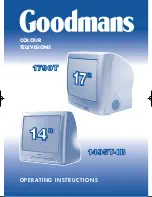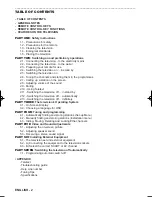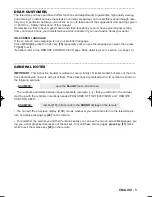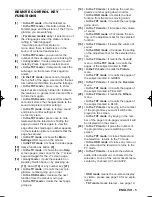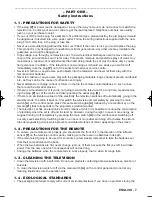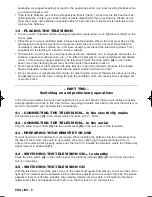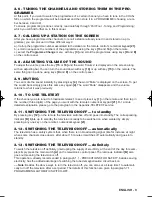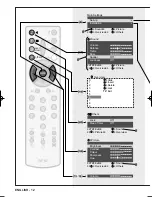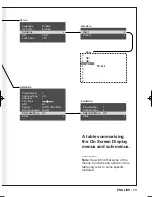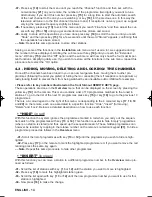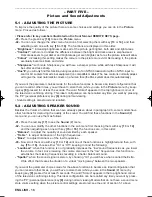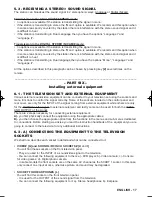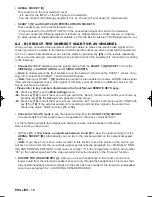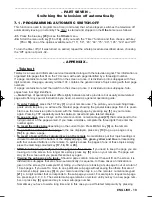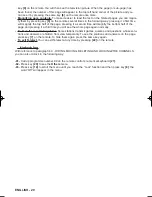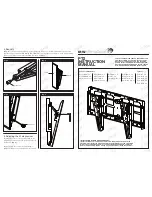
ENGLISH - 5
–––––––––––––––––––––––––––––––––––––––
REMOTE CONTROL KEY
FUNCTIONS
[1]
• In the TV mode • it turns Teletext on.
• In the TXT mode • this button mixes the
Teletext page and the picture of the TV pro-
gramme you are watching.
[2]
• For stereo models only • it selects one of
the 2 languages when the station is trans-
mitting in "dual language"
.
It switches sound from stereo to
mono when there is interference in the
sound of a stereo transmission.
[3]
• In the TXT mode • you can enter the
number of the sub-page you are looking for.
[4]
• In any mode • it mutes television sound
instantly. Press it again to restore sound.
[5]
• In the TXT mode • it temporarily locks the
sub-page on the screen. Press again to
unlock.
[6]
• In the TXT mode • press once to magnify
the top half of the page, a second for the bot-
tom half and a third time to view the full page.
[7]
• In the TXT mode • press once to show
texts that are normally hidden (for instance
the solutions to games) and a second time
to hide them again.
[8]
• In the OSD mode • if pressed for about 5
seconds it stores the changes made to the
sound and picture control settings.
• In the TV mode • press to restore sound
and picture control settings to thei
r
ex-facto
ry state.
• In the TXT mode • press once to hide
teletext while the television is finding the
page you want. Press again to view the
page after the small page number appears
on the television picture to indicate that the
page has arrived.
[9]
• In the TV mode • it shows the Main
Settings OSD menu on the screen.
• In the TXT mode • it shows the index page.
[10] Same function as button [6].
[11] • In the TV mode • it shows the two Help
screen pages: press once for the 1
st
screen
page and again for the 2
nd
screen page.
[12] • In any mode • it puts the television on
stand-by. Switch back on by pressing 'up'
[13], 'down' [14] or any number key [21].
[13] • In the TV mode • it recalls the next pro-
gramme number going up in order.
• In the OSD mode • it selects the next
function from the menus moving up.
• In the TXT mode • it calls the next page
going up.
[14] • In the TV mode • it calls up the next pro-
gramme number going down in order.
• In the OSD mode • it selects the next
function from the menus moving down.
• In the TXT mode • it recalls the next page
going down.
[15] • In the TV mode • it increases the volume
of sound.
• In the OSD mode • it increases the set-
ting on the adjustment bar for the selected
function.
[16] • In the TV mode • it lowers the volume of
sound.
• In the OSD mode • it reduces the setting
on the adjustment bar for the selected func-
tion.
[17] • In the TV mode • it recalls the Sound#
menu. • In the TXT mode • it recalls the
pages of the subject marked in RED.
[18] • In the TV mode • it recalls the Picture
menu.
• In the TXT mode • it recalls the pages of
the subject marked in GREEN
[19] • In the TV mode • it recalls the Overview
menu.
• In the TXT mode • it recalls the pages of
the subject marked in YELLOW.
[20] • In the TV mode • it recalls the Others
menu.
• In the TXT mode • it recalls the pages of
the subject marked in BLUE.
[21] • In the TV mode • by keying in the number
of the programme you want it will be dis-
played on the screen.
• In the TXT mode • by keying in the num-
ber of the page or sub-page you want it will
be displayed on the screen.
[22] • In the TV mode • it gives the number of
the programme you are watching on the
screen.
• In the TXT mode • it closes Teletext and
the television returns to the TV mode.
• In the OSD mode • it closes any menu or
sub-menu and the television returns to the
TV mode.
[23] • In the TV mode • it selects the external
audio-video equipment, connected to the
television, to one of the scart sockets repre-
sented by channels AV1 and AV2#.
- OSD mode means the on-screen display
is visible - please see page 10 for an expla-
nation.
- TXT mode means teletext - see page 19.
Testo del man. SWING (UK) 14-10-2002 9:41 Pagina 5

